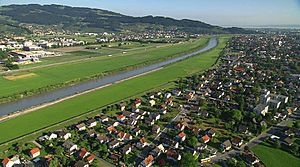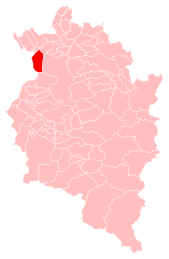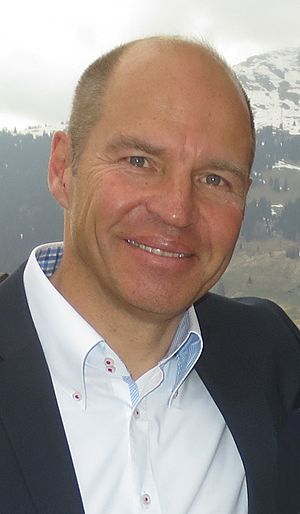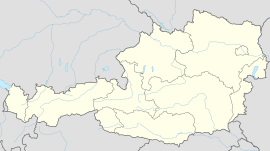Lustenau facts for kids
Quick facts for kids
Lustenau
|
||
|---|---|---|
|
Municipality
|
||
 |
||
|
||

Location of Lustenau within Vorarlberg
|
||
| Country | Austria | |
| State | Vorarlberg | |
| District | Dornbirn | |
| Elevation | 404 m (1,325 ft) | |
| Population
(2015)
|
||
| • Total | 22 821 | |
| Time zone | UTC+1 (CET) | |
| • Summer (DST) | UTC+2 (CEST) | |
| Postal code |
6890, 6893
|
|
| Area code | 05577 | |
| Vehicle registration | DO | |
| Website | www.lustenau.at | |
Lustenau (pronounced LOO-stuh-now) is a town in the western part of Austria. It is located in the state of Vorarlberg, which is in the Dornbirn area.
The town sits right on the Rhine river. This river forms the border between Austria and Switzerland. Lustenau is the fourth largest town in Vorarlberg.
Contents
Geography of Lustenau
Lustenau is found on the eastern side of the Alpine Rhine river. This river creates the border with the Canton of St. Gallen in Switzerland. The town is about 404 meters (1,325 feet) above sea level.
Since Lustenau is in the flat Rhine Valley, there are no big hills or mountains nearby. The Rhine river borders the town to the west. To the northeast, you'll find the Dornbirner Ach river. The town stretches about 8.5 kilometers (5.3 miles) from north to south. It is about 4 kilometers (2.5 miles) wide from east to west.
Connecting to Switzerland
Four bridges help connect Lustenau with Switzerland. The town is divided into four main areas, which locals often call parishes. These are Rotkreuz, Rheindorf, Kirchdorf, and Hasenfeld.
The main church square in Lustenau is painted blue. Because of this, the town center is known as the "Blue Square" (or "Blauer Platz" in German).
History of Lustenau
The name Lustenau first appeared in a document from January 24, 887. This document was signed by King Charles the Fat. It called the town "Lustenauua curti regali," which means "Royal Court of Lustenau."
In 1395, the Counts of Werdenberg gave the Zwingenstein fortress and Lustenau to the Knights of Ems. By 1526, this was a full purchase. After the Hohenems family line ended in 1759, there was a long argument over who owned Lustenau. Maria Theresa of Austria and the Hohenems heiress Maria Rebekka both claimed it.
Until 1830, Lustenau was an independent area. It was ruled by the Counts of Waldburg-Zeil-Lustenau-Hohenems. After 1830, it became part of Austria. During a difficult time in history, there was no organized resistance against the ruling power in Lustenau. However, many people showed individual bravery. They were punished for their actions. After the Second World War, the local embroidery industry helped Lustenau's economy grow a lot.
People of Lustenau
The first count of people in Lustenau happened in 1750. It showed that 1,073 people lived there. For much of its history, Lustenau grew faster than other parts of Vorarlberg. This was especially true when the embroidery industry became strong. Also, flood problems were solved in the late 1800s. This led many people to move to Lustenau. They came from other towns in Vorarlberg, the rest of Austria, and southern Germany.
Another big wave of people moved to Lustenau in the 1950s and 1960s. This happened because the economy grew very strong again after the Second World War.
Special Characteristics of the Population
For hundreds of years, Lustenau was quite separate from its neighbors. This was because of its special position as a "Royal Court." It wasn't until 1837 that men from other places could become citizens. Because of this, a unique dialect developed in Lustenau. It sounds different from other Alemannic dialects in the area.
Another result of Lustenau's long independence is that a few family names are very common. Names like "Hämmerle," "Grabherr," and "Bösch" are very popular. In 1806, only 19 family names were shared by 1,998 people. By 1950, 60% of the population still had these same names. This is why using house names was even more common in Lustenau than in other parts of Vorarlberg. This practice lasted from the 1600s until the late 1900s.
In the past, Lustenau was a major center for the embroidery industry. Today, it is a hub for new technology companies.
Regular Events in Lustenau
Every summer, for over 30 years, a group called "Szene Lustenau" holds an open-air festival. It takes place on the Rhine river bank. This festival is called Szene Openair. It is the biggest festival in Western Austria.
The event features international artists and local bands. More than 10,000 visitors come from all over Austria, Germany, Switzerland, and Liechtenstein. Over 450 volunteers help make the festival happen.
The Kilbi is the parish fair for St. Peter and Paul church. It is the largest fair in Vorarlberg. Every year on the second Sunday in October, about 160 market stalls sell their goods at the church square. A temporary amusement park is also set up for the Kilbi. It has roller coasters, carousels, and other fun rides. On the Saturday before the Kilbi, a party called "Kilbifest" is held.
Transport in Lustenau
Lustenau railway station is on the line that runs between St. Margrethen in Switzerland and Bregenz. The S3 and R5 train services of Vorarlberg S-Bahn stop here.
Lustenau is also home to the main office of the International Rhine Regulation Railway. This is a historic industrial railway. It was once used to help build dikes and extend the Rhine river into Lake Constance.
Sports in Lustenau
Lustenau has a long and successful history in sports. The town has two football teams. These are SC Austria Lustenau and FC Lustenau. They play in major Austrian football leagues.
The famous skier, Marc Girardelli, was born in Lustenau. The town's ice hockey team, EHC Lustenau, is part of the Austrian National League. FC Lustenau 07 and SC Austria Lustenau play in the Austrian Football Bundesliga at different levels.
There are also two very good athletics and gymnastics clubs in Lustenau. These are the TS (Turnerschaft) Lustenau and the TS (Turnerschaft) Jahn Lustenau. Both clubs have achieved top results in Austria and internationally. They have done well even though football clubs are very popular.
Notable People from Lustenau

- Stephanie Hollenstein (1886–1944), an Austrian artist known for landscape and still-life paintings.
- Fredmund Malik (born in 1944), an economist and Austria's honorary consul in Switzerland.
Sports Figures
- Manfred Schurti (born in 1941), a former racing car driver from Liechtenstein.
- Marc Girardelli (born in 1963), a skier who won two silver medals at the 1992 Winter Olympics.
- Markus Peintner (born in 1980), an ice hockey player.
- René Swette (born in 1988), an ice hockey player.
- Barbara Gasser (born in 1989), a gymnast who grew up in Lustenau.
- Pius Grabher (born 1993), an Austrian footballer who has played over 260 games.
Images for kids
See also
 In Spanish: Lustenau para niños
In Spanish: Lustenau para niños





